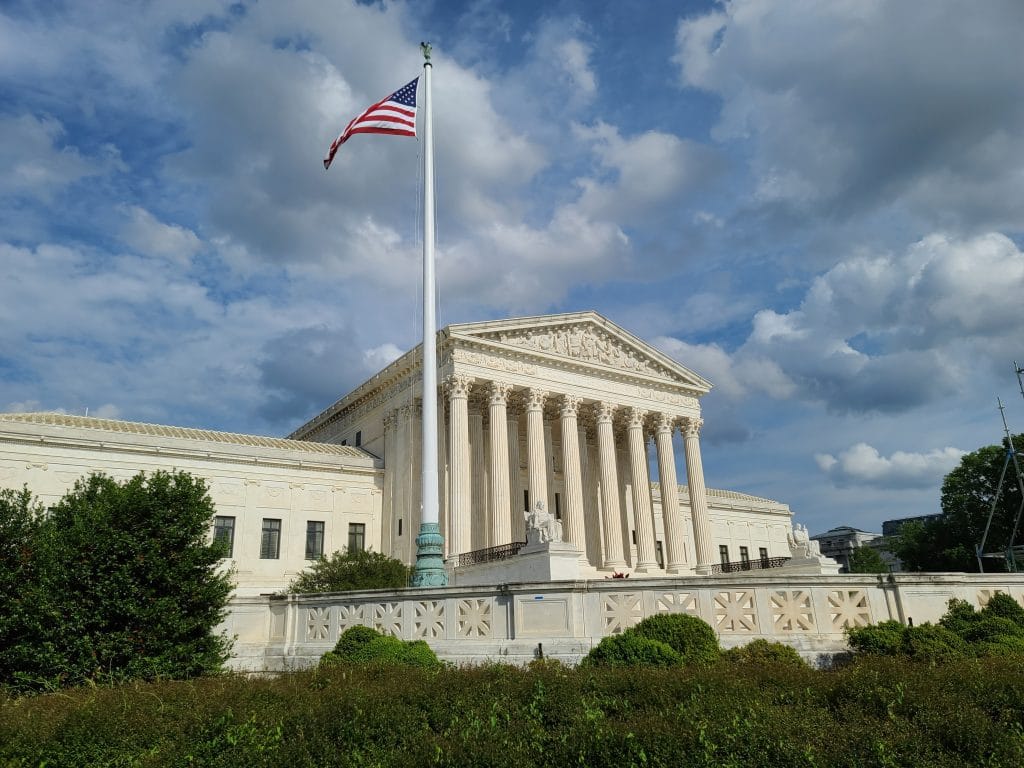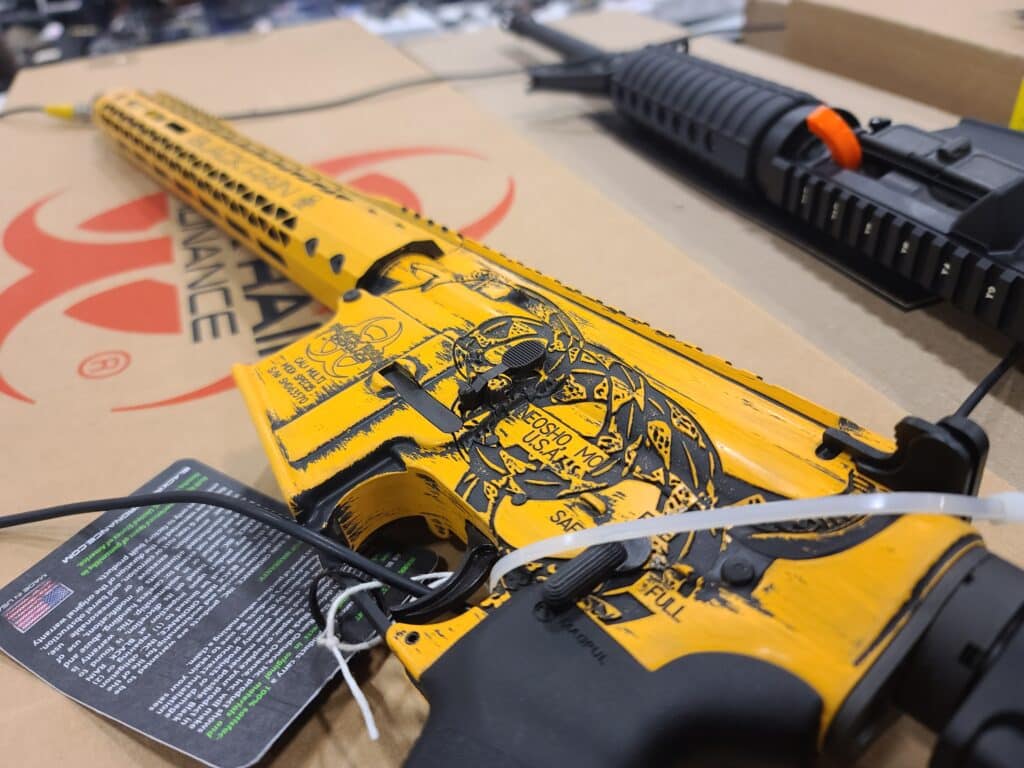The Supreme Court looms large over our gun policy. It has gotten involved in a handful of cases since issuing its landmark Bruen decision last year, including issuing another emergency stay in the Fifth Circuit ghost gun case this week. But the biggest upcoming moment for the Court is going to be its decision in United States v. Rahimi.
To that end, Contributing Writer Jake Fogleman examines Rahimi’s newly-filed defense. How do his arguments compare to the ones employed by the government?
I also take a look at what a federal judge’s finding that the Second Amendment rights of plaintiffs in the case against the pistol-brace ban were violated means for other hardware bans. The injunction in the case still revolves around the idea the ATF went beyond its power under the Administrative Procedure Act, but the judge’s determination that braced pistols are “in common use” is very notable. He is one of the first to put a more specific number range on what constitutes common use.
Plus, USCCA’s Katie Pointer Baney explains the plan for the gun-carry group’s new political arm on the podcast.

Analysis: What Rahimi is Arguing in the Upcoming Supreme Court Gun Case [Member Exclusive]
By Jake Fogleman
With oral arguments in the Court’s next big Second Amendment case less than a month out, all eyes are on how the two sides plan to argue United States v. Rahimi.
We reviewed the Government’s brief when it came out in August. Now, let’s look at Defendant Zackey Rahimi’s newly filed arguments with the Court. His brief lays out the leading critique of the domestic violence restraining order gun ban he was charged with violating. Unsurprisingly, his lawyers would like the High Court to uphold the Fifth Circuit ruling striking down that law as unconstitutional and vacating Rahimi’s conviction.
“This Court should affirm the decision below because it faithfully applied the holdings and reasoning of District of Columbia v. Heller and New York State Rifle & Pistol Ass’n v. Bruen,” the brief opens.
The brief primarily accuses the Government of failing to properly engage with the text, history, and tradition test required under Bruen in its justification for 18 U.S.C. § 922(g)(8). The brief asserts that’s because America’s Founding Era approach to individuals considered part of “the People” protected by the Second Amendment foreclosed categorical disarmament.
“The Second Amendment protects a U.S. citizen’s right to keep firearms within the home for self-defense and defense of others. Section 922(g)(8) severely punishes any exercise of that right,” Rahimi’s lawyers wrote. “Because there is no historical tradition of any similar restriction, the law is unconstitutional on its face.”
Domestic Violence and the Founding
Contrary to the assertions of the Government and several of its supporting amici, Rahimi’s brief argued that the issue of domestic violence was taken seriously around the time of the Second Amendment’s ratification. But, as is relevant for the Bruen test, their approach didn’t include gun bans.
“In the 17th, 18th, and early 19th centuries, Americans recognized the scourge of domestic violence and utilized a variety of legal and extra-legal mechanisms to punish, prevent, and deter it,” the brief reads. “None of those mechanisms involved disarmament or firearm bans.”
His lawyers argued that surety laws—whereby an individual suspected of being a risk to the peace was forced to post a bond as a guarantee of good behavior—were commonly applied to the husbands of women who informed a local justice of the peace of ongoing abuse. They also cited the early liberalization of divorce laws in certain states to allow for “absolute divorce on the grounds of cruelty.” Finally, they pointed to more informal practices carried out by family and community members to address domestic violence, namely sheltering battered women and public shaming rituals for abusers.
But the brief notes none of the remedies for abuse had anything to do with denying access to firearms or otherwise restricting gun rights.
“All these responses differed materially from § 922(g)(8) because none banned or even restricted firearm possession,” Rahimi’s legal team wrote. “As explained below, American jurisdictions simply did not ban firearm possession for citizens who retained their position in the political community.”
Historical Disarmament Laws
The brief’s overarching position on historical analogues for 922(g)(8) contends that governments around the time of the Founding had an understanding that privately owned guns specifically for use in the home represented a “zone of immunity” with respect to firearms regulations. It also suggests that many historical instances of disarming certain classes of people were done under the assumption that those people fell outside the political community. Therefore, all of the Government’s offered analogues for the modern ban on gun possession by those under domestic violence restraining orders differ in “how” and “why” they impact the right to keep and bear arms since they primarily either regulated public carry or disarmed groups considered outside of “the People.”
The brief also criticized the citation of often bigoted historical laws that disarmed certain groups—such as Native Americans, enslaved and free blacks, multiracial people, loyalists, Quakers, and Catholics—as a potential historical analogue.
“The Government and its amici overlook the most significant point: laws banning firearm possession by disfavored categories of people have invariably attended a broader effort to deny the political and civil rights of the affected class,” the brief reads. “As the Fifth Circuit recognized, these bigoted laws were ‘targeted at groups excluded from the political community—i.e., written out of ‘the people’ altogether.'”
“Consider the Kentucky law cited on page 15 of the Public Health Researchers and Lawyers’ Amicus Brief, which banned every ‘negro, mulatto, [and] Indian whatsoever’ from keeping any gun, club, or other ‘offensive or defensive’ weapon,” the brief continued. “This type of law says nothing about ‘the right to keep and bear arms.’ Enslaved people and free blacks were, at that time and place, entirely excluded from the political community. The same legislation forbade free blacks and multiracial people from exercising other rights of citizenship: giving testimony in any case involving at least one white party; meeting, in groups of five or more at someone else’s plantation or quarters; and ‘lifting his or her hand in opposition to’ any white person, on pain of ‘thirty lashes.'”
The brief extends this same argument to historical laws targeting the gun rights of Catholics, Loyalists, and rebels to underscore that such laws were passed not of a finding or perception of “dangerousness” but out of a bigoted understanding of who was and was not included in the American political community.
Addressing the Heller Dicta
Rahimi also responded to the argument, which the Government relied on in its brief to the Court, that the Supreme Court’s own words in previous Second Amendment cases suggest that the right to keep and bear arms is limited to “law-abiding, responsible citizens” and that certain gun bans are therefore “presumptively lawful.” It argued that the Bruen decision and the specific Second Amendment legal test it articulated overruled those non-binding statements, and now courts are required to analyze firearm prohibitions individually using the test.
“The Government cannot meet its burden by pointing to Heller’s ‘felon’ dictum or to other bans that first appeared in the 20th century,” the brief states. “Bruen put a stop to this. The original meaning of the Second Amendment must be determined exclusively using the text and the historical tradition of firearm regulations adopted near the time of ratification—not with assumptions or dicta.”
“Said another way, Heller’s tentative ‘presumptively lawful’ categories are not valid bases for constitutional comparison,” it continued.
Ultimately, the brief takes a narrow view of what constitutes a valid historical analogue for modern-day disarmament.
“Despite casting an incredibly broad net, the Government has yet to find even a single American jurisdiction that adopted a similar ban while the founding generation walked the earth,” Rahimi’s brief said. “The Government cites no laws punishing members of the American political community for possessing firearms in their own homes based on dangerousness, irresponsibility, crime prevention, violent history or inclination, or any other character trait or legislative goal.”
Podcast: Inside a Nationwide Gun-Carry Group’s New Political Efforts (Ft. USCCA’s Katie Pointer Baney) [Member Early Access]
By Stephen Gutowski
This week, we’re taking an in-depth look at a new player in the gun politics space.
Although, the main reason this group is worth paying attention to is that they aren’t new to being an influential gun group. The United States Concealed Carry Association (USCCA) has been a significant presence in concealed-carry insurance and firearms training for a decade. They created a Super PAC two years ago as their first foray into organized political activism, and now they’ve followed that up by forming a new 501(c)(4) non-profit.
Katie Pointer Baney, the head of the new Action Fund, joins the show to give us insight into what she has planned.
The decline of the NRA has left a sizeable hole in the gun-rights movement, but Baney said calls from USCCA members to get more involved in politics were the main motivator for creating the new group. She said the plan is to focus on training activists rather than buying ads or filing lawsuits. Targeting millions of Americans of all different stripes and backgrounds who have become gun owners in the past three years is how the Action Fund will try to differentiate itself from other efforts.
Plus, Contributing Writer Jake Fogleman and I talk about a federal judge finding braced pistols are “in common use” and protected by the Second Amendment.
You can listen to the show on your favorite podcasting app or by clicking here. Video of the episode is available on our YouTube channel. Reload Members get access on Sunday, as always. Everyone else can listen on Monday.

Analysis: Pistol Brace Ruling Implies Second Amendment Protects AR-15s, Ammo Mags, and Silencers [Member Exclusive]
By Stephen Gutowski
“[T]he Court finds that braced pistols regulated under the Final Rule are commonly used by law-abiding citizens for lawful purposes.”
That may be the most influential finding in Judge Reed O’Connor’s decision enjoining the ATF’s pistol brace rule. It strikes at a key part of the fight over gun and accessory bans across the country. And how Judge O’Connor reached his conclusion provides new insight into the threshold other courts may employ to determine whether the Second Amendment protects a banned item.
Working off of Supreme Court precedent in 2008’s District of Columbia v. Heller, 2010’s McDonald v. Chicago, and 2022’s New York State Rifle and Pistol Association v. Bruen, Judge O’Connor established the test for whether the Constitution protects an arm is whether it’s in lawful common use or not. And he said the Court had already determined modern handguns fit the bill.
“A weapon is in ‘common use’ rather than ‘dangerous and unusual’ if it is ‘commonly possessed by law-abiding citizens for lawful purposes today,’” he wrote. “The relevant inquiry under this standard is the current total number of a particular weapon that is in lawful possession, ownership, and circulation throughout the United States. As a per se matter, semiautomatic pistols are commonly used weapons for lawful self-defense purposes across the United States today.”
From there, he found adding a brace to a pistol “does not somehow alter that status and effectively strip these pistols of their Second Amendment protection.” Then he argued the ATF’s own estimate for how many braced pistols have been legally purchased over the years directly undercut its argument they could be banned or significantly restricted.
“The Government Defendants’ assertion to the contrary—that pistols do become dangerous and unusual as soon as stabilizing braces are attached to them—does not survive its own administrative record,” Judge O’Connor wrote. “The ATF’s regulatory analysis concludes that there are between 3 and 7 million, with a fifty percentile estimate of 5 million, braced pistols under the ownership of law-abiding individuals for lawful purposes throughout the United States.”
That estimate comes from the agency’s impact assessment for the rule. But those numbers are actually on the lower end of the spectrum. The Congressional Research Service found braced pistols are even more common, estimating there are between 10 to 40 million in civilian hands. Regardless, Judge O’Connor argued the fact that everyone agrees there are at least millions of these guns puts them squarely in the “common use” category.
“In the Final Rule publication as well, ATF did not dispute noteworthy public comments pointing out that ‘millions of ‘braces’ are in use’ and that braced pistols are ‘commonly used by millions of law-abiding Americans for various reasons,’” he wrote. “On the other hand, ATF even conceded that since 2012, ‘the variety of available ‘stabilizing braces’ or similar ‘brace’ devices and pistols equipped with ‘braces’ has grown significantly.’ Supreme Court guidance and sister circuit precedent postulate that this record is dispositive of the matter.”
Judge O’Connor isn’t alone in this determination either. When a Fifth Circuit Court of Appeals panel reviewed the ATF’s rule, it blocked it after finding the agency exceeded its statutory power. However, Judge Don Willett wrote a concurrence where he also argued that braced pistols are in common use and protected by the Second Amendment.
“Rearward attachments, besides making a pistol less concealable, improve a pistol’s stability, and thus a user’s accuracy. Accuracy, in turn, promotes safety,” Willett wrote in a concurrence. “In my view, protected Second Amendment’ conduct’ likely includes making common, safety-improving modifications to otherwise lawfully bearable arms.”
Supreme Court Justice Samuel Alito has also opined on this point in a concurrence. While 2016’s Caetano v. Massachusetts was primarily about establishing the Second Amendment extended to modern-day arms, he argued the existence of as little as 200,000 stun guns made them protected.
“The more relevant statistic is that ‘[h]undreds of thousands of Tasers and stun guns have been sold to private citizens,’ who it appears may lawfully possess them in 45 States,” he wrote. “While less popular than handguns, stun guns are widely owned and accepted as a legitimate means of self-defense across the country. Massachusetts’ categorical ban of such weapons therefore violates the Second Amendment.”
But even if you back off to Judge O’Connor’s standard that millions of the affected arms have to be in civilian hands to be protected, that has massive implications for some of the most contentious gun laws in the country. Nearly every high-profile hardware ban would likely be affected because of how popular their targets are with Americans.
The prevalence of different guns and accessories is often challenging to quantify because most aren’t registered. Estimates are generally inexact at best. For instance, nobody keeps track of how many ammunition magazines are produced each year, and estimates of their popularity are probably among the least reliable. The disparate nature of various state magazine bans, with different states setting capacity limits at 10 or 15 or 17 rounds, also limits how accurate estimates of affected arms can be.
Still, so-called high-capacity magazines are probably the most common of the banned arms out there today. The vast majority of modern handguns and semi-automatic rifles come standard with multiple magazines that at least hold more than 10 rounds of ammunition. Plaintiffs in one suit against Rhode Island’s ban estimated there are 115 million in circulation, according to Courthouse News Service. Even if they’re off by an order of magnitude, that still puts the magazines comfortably in the realm of protected arms under Judge O’Connor’s reasoning (of course, there’s also a live legal debate over whether they qualify as arms at all).
A number of federal judges have already come to this conclusion since last year’s Bruen ruling. Most recently, Judge R0ger Benitez determined California can’t ban magazines because they are in common use.
“This case is about a California state law that makes it a crime to keep and bear common firearm magazines typically possessed for lawful purposes,” Judge Benitez wrote in Duncan v. Bonta. “Based on the text, history, and tradition of the Second Amendment, this law is clearly unconstitutional.”
The estimate for how many AR-15s and similar firearms, often targeted in “assault weapon” bans, is smaller than that of magazines but also a bit more reliable. The National Shooting Sports Foundation, the gun industry’s trade group, reported last year that more than 24.4 million AR-15s and AK-47s are in civilian hands. That number was pulled from decades of ATF manufacturing reports, which don’t track specific models but do give a general overview of firearm type.
That puts ARs comfortably into the millions, even if it ends up being an extreme overcount. The number of rifles in circulation hasn’t been key thus far in the post-Bruen assault weapon ban cases, most of which haven’t gotten as far as similar magazine challenges, but it’s likely to determine whether those bans ultimately stand or fall.
The number of silencers in circulation is smaller still than AR-15s, but the estimate of how many exist is also more reliable. As of May 2021, Americans have registered 2,664,774 silencers with the ATF under the National Firearms Act (NFA). That’s a very reliable count because the NFA requires civilians to register all of their sound suppressors with the agency or face potential prosecution. That puts the number of silencers slightly below the ATF’s estimate for the number of braced pistols. But not by much.
That could make a future challenge of the NFA’s registration requirements viable, at least as they apply to silencers.
Of course, gun-rights activists have been pushing courts to adopt this line of thinking since Heller was handed down 15 years ago. And Judge O’Connor is just a district court judge. His ruling isn’t binding on anyone but the parties to the case. Other federal judges don’t have to follow his reasoning. The same is true of single-judge concurrences, even all the way up at the Supreme Court.
But, if Judge O’Connor’s standard for determining “common use” proves to be influential, it will upend gun policy in the ways gun-rights advocates have been hoping, and gun-control advocates have been dreading, for a generation.
That’s it for now.
I’ll talk to you all again soon.
Thanks,
Stephen Gutowski
Founder
The Reload






